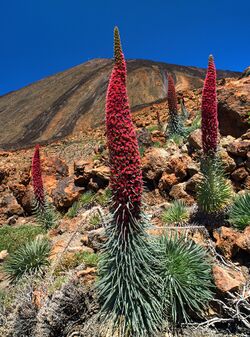Biology:Echium wildpretii
| Echium wildpretii | |
|---|---|

| |
| Echium wildpretii on Tenerife | |
| Scientific classification | |
| Kingdom: | Plantae |
| Clade: | Tracheophytes |
| Clade: | Angiosperms |
| Clade: | Eudicots |
| Clade: | Asterids |
| Order: | Boraginales |
| Family: | Boraginaceae |
| Genus: | Echium |
| Species: | E. wildpretii
|
| Binomial name | |
| Echium wildpretii H.Pearson ex Hook.f.
| |
Echium wildpretii is a species of flowering plant in the family Boraginaceae. It is an herbaceous biennial plant that grows up to 3 m (10 ft) in height. The species is endemic to the Canary Islands, and is found mainly in the national park surrounding Mount Teide in Tenerife. The subspecies E. wildpretii subsp. trichosiphon occurs at high altitudes on the island of La Palma. The common names are tower of jewels, red bugloss, Tenerife bugloss or Mount Teide bugloss.[1]
Etymology
The Latin specific epithet wildpretii honours the 19th century Swiss botanist Hermann Josef Wildpret.[2]
Description
It is a biennial, producing a dense rosette of leaves during the first year, flowers in the second year, and then dies. The red flowers are borne on an erect inflorescence, 1–3 m (3 ft 3 in–9 ft 10 in). The plant blooms from late spring to early summer in Tenerife.
Habitat
The plant grows in the subalpine zone of the ravines of Mount Teide, a volcano on Tenerife in the Canary Islands, Spain. It requires a lot of sun and is found in arid and dry conditions, but it tolerates frost down to −5 °C (23 °F). As a sub-alpine endemic plant with a narrow climatic niche and small distribution, the species is likely to be negatively impacted by climate change.[3][4]
Uses
This plant can be found as a garden ornamental but is intolerant of low temperatures, thus some winter protection is required in frost-prone areas. It has gained the Royal Horticultural Society's Award of Garden Merit.[5][6] As with most buglosses, it is favoured by bee-keepers for its high nectar content.
References
- ↑ Bramwell, D and Bramwell, Z (2001) Wild flowers of the Canary Islands. 2nd edition. Editorial Rueda SL, Madrid, Spain ISBN:84-7207-129-4.
- ↑ Harrison, Lorraine (2012). RHS Latin for Gardeners. United Kingdom: Mitchell Beazley. ISBN 978-1845337315.
- ↑ Dirnböck, Thomas; Essl, Franz; Rabitsch, Wolfgang (February 2011). "Disproportional risk for habitat loss of high-altitude endemic species under climate change: HABITAT LOSS OF HIGH-ALTITUDE ENDEMICS". Global Change Biology 17 (2). doi:10.1111/j.1365-2486.2010.02266.x.
- ↑ Graham, Rachael E.; Reyes-Betancort, J. Alfredo; Chapman, Mark A.; Carine, Mark A. (4 July 2021). "Inter-island differentiation and contrasting patterns of diversity in the iconic Canary Island sub-alpine endemic Echium wildpretii (Boraginaceae)". Systematics and Biodiversity 19 (5): 507–525. doi:10.1080/14772000.2021.1877847. https://eprints.soton.ac.uk/446576/1/Echium_microsats_revised_manuscript.pdf.
- ↑ "Echium wildpretii". Royal Horticultural Society. https://www.rhs.org.uk/Plants/6299/Echium-wildpretii/Details. Retrieved 5 June 2020.
- ↑ "AGM Plants - Ornamental". Royal Horticultural Society. July 2017. p. 35. https://www.rhs.org.uk/plants/pdfs/agm-lists/agm-ornamentals.pdf. Retrieved 6 February 2018.
External links
| Wikimedia Commons has media related to: |
Wikidata ☰ Q162998 entry
 |



